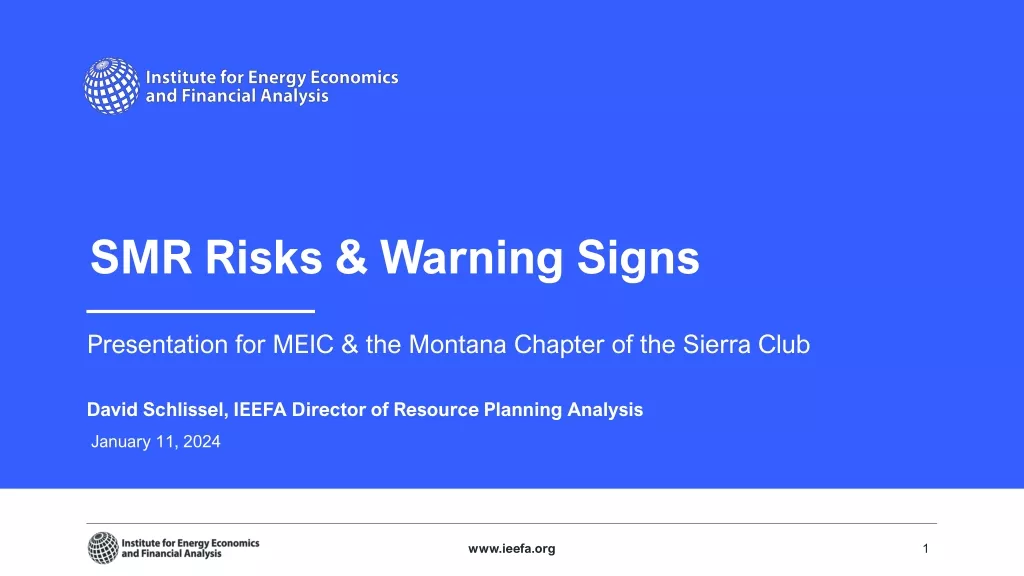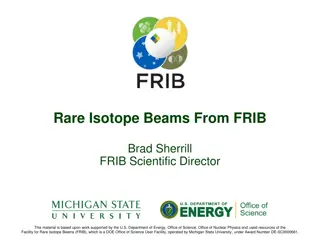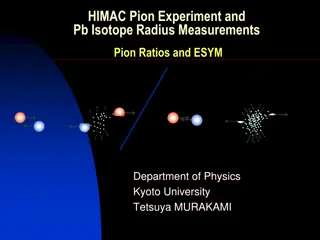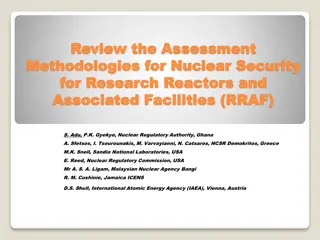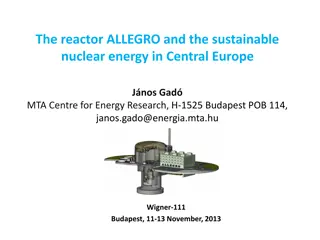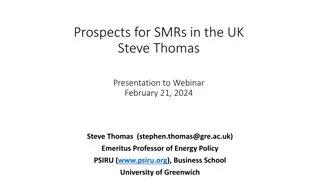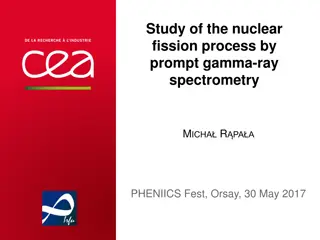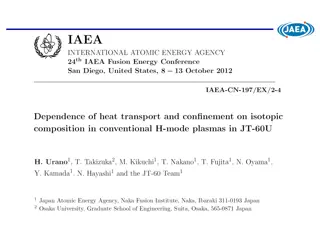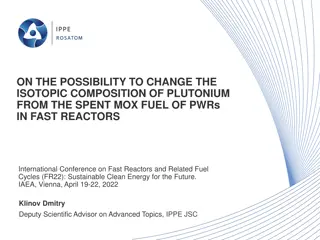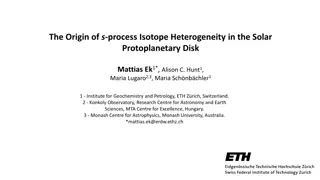Importance of Optimizing Nuclear Data for Isotope Production in Reactors
Optimizing nuclear data is crucial for enhancing isotope production efficiency in reactors. Improved cross section data can lead to cost reductions and material savings by enabling better production optimization. Specific cross sections are required for heavy isotope production, as well as for medical isotope research campaigns. Uncertainties in data for 229Th production simulations highlight the need for accurate and reliable nuclear data sources.
Download Presentation

Please find below an Image/Link to download the presentation.
The content on the website is provided AS IS for your information and personal use only. It may not be sold, licensed, or shared on other websites without obtaining consent from the author.If you encounter any issues during the download, it is possible that the publisher has removed the file from their server.
You are allowed to download the files provided on this website for personal or commercial use, subject to the condition that they are used lawfully. All files are the property of their respective owners.
The content on the website is provided AS IS for your information and personal use only. It may not be sold, licensed, or shared on other websites without obtaining consent from the author.
E N D
Presentation Transcript
Nuclear Data Infrastructure Needs for Isotope Production in Reactors Catherine Romano WANDA2020 Washington, DC March 3-5, 2020 ORNL is managed by UT-Battelle, LLC for the US Department of Energy OAK RIDGE NATIONAL LABORATORY Oak Ridge, Tennessee 37831-6283 managed by UT-BATTELLE, LLC for the U.S. DEPARTMENT OF ENERGY under contract DE-AC05-00OR22725
Why is Optimizing the Nuclear Data for Isotope Production Important? An improvement in the cross section data can enable optimization of production For Example: Simulations using accurate nuclear data optimize isotope production within a target by 10% 10% fewer targets require production, irradiation and post-processing to obtain the same amount of material 10% reduction in cost of production Open slide master to edit 2 2
What cross sections are needed? Cross sections for heavy isotope production including Bk, Cf and Fm J.B. Roberto, C.W. Alexander, R.A. Boll, J.D. Burns, J.G. Ezold, L.K. Felker, S.L. Hogle, K.P. Rykaczewski, Actinide targets for the synthesis of super-heavy elements, Nuclear Physics A, Volume 944, 2015, Pages 99-116, ISSN 0375-9474, https://doi.org/10.1016/j.nuclphysa.2015.06.009. Open slide master to edit 3 3
Important Cross Sections for Medical Isotope Production Research Campaigns: Ra-226(3n, )Ra-229 Ac-229 Th-229 Yb-176(n, )Lu-177 Se-74(n, )Se-75 Os-190(n, )Os-191 Pt-195(n,n )Pt-195m Sn-117(n,n )Sn-117m Production Campaigns: Ra-226(n, )Ra-227 Ac-227 W-186(2n, )W-188 Sr-88 (n, )Sr-89 Ba-132(n, )Ba-133 Missing Gamma Production Data (GPD) in Various Source Libraries Local heating rates can be significantly affected Greatly impacts target loading and approval process Neutron induced gamma emission needs to be understood (n,n ) and (n, ) Fission cross sections become very important! Open slide master to edit 4 4
Cross Sections Used in 229Th Production Simulations 229Th production data have particularly high uncertainties ORIGEN Effective Cross Section (b) 14.2 missing ISOCHAIN Effective Cross Section (b) 22.3 457 Reaction Data Source Uncertainty (%) Measured/ Calculated 226Ra(n, ) 227Ra(n, ) JENDL 3.3 Hogle et al., 2016d KAPL Chart of Nuclides TENDL-2017 JENDL 3.3 TENDL-2017 TENDL-2017 ENDF/B-VII.0 JENDL 3.3 ENDF/B-VII.0 ENDF/B-VII.0 ENDF/B-VII.0 ENDF/B-VII.0 11.7 - Target Product Ra-226 Th-228 0.61 228Ra(n, ) 36 - 8.7 Ra-228 Th-229 0.24 229Ra(n, ) 227Ac(n, ) 228Ac(n, ) 229Ac(n, ) 227Th(n, ) 227Th(n,f) 228Th(n, ) 228Th(n,f) 229Th(n, ) 229Th(n,f) 9.5 945 13.6 7.8 1582 209 159 0.33 105 46 - missing 239 missing missing 441 236 63 0.20 145 38 Ra-228 Th-230 0.72 2.6 - - - 6.4 11.1 - 13.8 11.7 dHogle, S.; Boll, R. A.; Murphy, K.; Denton, D.; Owens, A.; Haverlock, T. J.; Garland, M.; Mirzadeh, S., Reactor production of Thorium- 229. Applied Radiation and Isotopes 2016, 114, 19-27. Open slide master to edit 5 5
What infrastructure is required to support nuclear data experiments? Beam experiments: May be used to obtain differential cross sections on longer lived isotopes (Es, Fm, Cf, Cm) Typically very small amounts available (nanograms in some cases) LSDS at RPI is possible In reactor experiments: Only method for shorter half-life isotopes Provide Integral or 2-group cross sections (thermal and resonance integral) Capture/fission ratio has lower uncertainty and is very useful Effective cross section: Geometry and flux specific Flux-independent cross section: Requires good characterization of flux and high fidelity models HFIR is an optimum location for in-reactor cross section experiments Very stable flux during each cycle and from cycle to cycle Highest flux in U.S. can overcome short half-lives Availability of target material in neighboring facility High fidelity validated models are available Open slide master to edit 6 6
HFIRCON is a modeling tool to optimize HFIR target depletion predictions Combines an adjoint flux calculation using ADVANTG with validated MCNP HFIR model 47 neutron groups ~ 2 million cells Accounts for depletion of fuel, control rods and all targets in HFIR Figure from Joel Risner and David Chandler, ORNL Open slide master to edit 7 7
MCNP Without ADVANTG Results Total Flux Relative Error Open slide master to edit 8 8
MCNP with ADVANTG Results Total Flux Relative Error Open slide master to edit 9 9
Highly Detailed Geometry in both SCALE and MCNP Models Pellet with 80 depletion zones Figure from Charles Daily, ORNL Germina Ilas, Ben Betzler, David Chandler, Eva Sunny, PHYSOR 2016, Sun Valley, ID, May 4, 2016 Open slide master to edit 10 10
LDRD funds are being used to Validate Flux Spectrum, Develop Sensitivity Analysis of Depletion Calculations and to Conduct Nuclear Data Experiments STAYSL-PNNL in combination with multiple flux wires are used to unfold the spectrum in common irradiation locations Unfolded flux is used to validate simulations Sensitivity tool (ORSEN) uses depletion perturbation theory to determine irradiated target isotopics sensitivity to nuclear data Nuclear data target production, irradiation protocols and post-irradiation analysis being established Justin Knowles, Steven Skutnik, David Glasgow, Roger Kapsimalis, Nuclear Instruments and Methods in Physics Research Section A: Accelerators, Spectrometers, Detectors and Associated Equipment, Volume 833,2016,pp. 38- 44,ISSN 0168-9002, https://doi.org/10.1016/j.nima.2016.06.112 Unfolded flux spectrum in pneumatic tubes 1 and 2 Open slide master to edit 11 11
Depletion perturbation theory for nuclear data sensitivity The ORSEN (ORigen SENsitivity) module of ORNL s SCALE code system uses depletion perturbation theory to determine the sensitivity of post- irradiation nuclide concentrations to nuclear data. Reactions with some of the highest sensitivities for 229Th production ORSEN calculates the sensitivity of the production of isotope Y to cross section X Nuclide/ reaction DPT sensitivity 226Ra (n,?) 0.98918 227Ac (n,?) 0.77590 228Th (n,?) 0.94692 228Ac decay 0.10839 229 Th fission -0.01686 Open slide master to edit 12 12
Infrastructure needs for nuclear data experiments Improvements to the HFIRCON code specific to cross section measurements Mid-cycle start and stop of irradiations Incorporation of ORSEN into ORIGEN depletion code Measurement of missing cross sections Nuclear Data Target Production, Irradiation and Post- Irradiation Analysis New thermal filter development (cadmium metal melts!) Cadmium carbide capsules, boron carbide capsules (possibly 3D printed) Substitute for quartz vials Difficult to seal and activate with high energy beta decay Target backings Flexible graphite Open slide master to edit 13 13
Infrastructure needs for nuclear data experiments Post-irradiation analysis improvements Set of 4 Compton-suppressed HPGe Clover detectors to reduce unwanted background from highly activated targets and reduce uncertainties Detector within the hot cell or along the pneumatic tube to conduct gamma measurements on very short half-life isotopes. Open slide master to edit 14 14
QUESTIONS? Open slide master to edit 15 15


